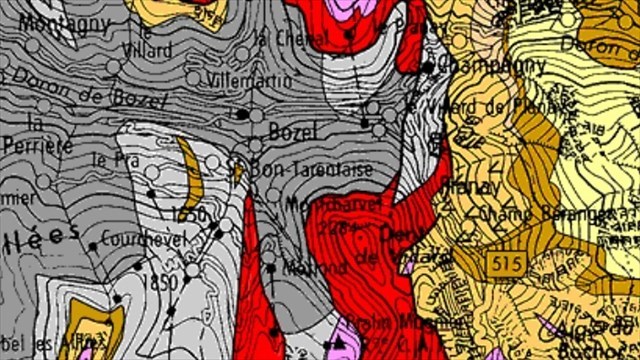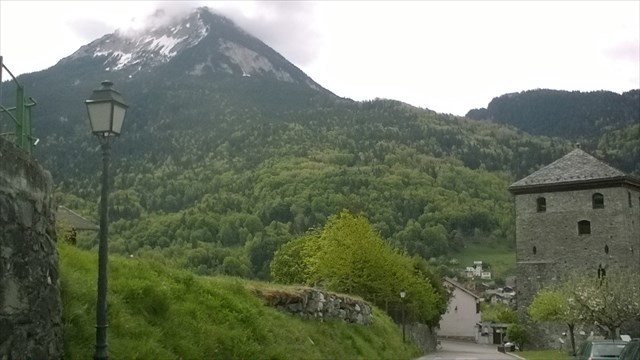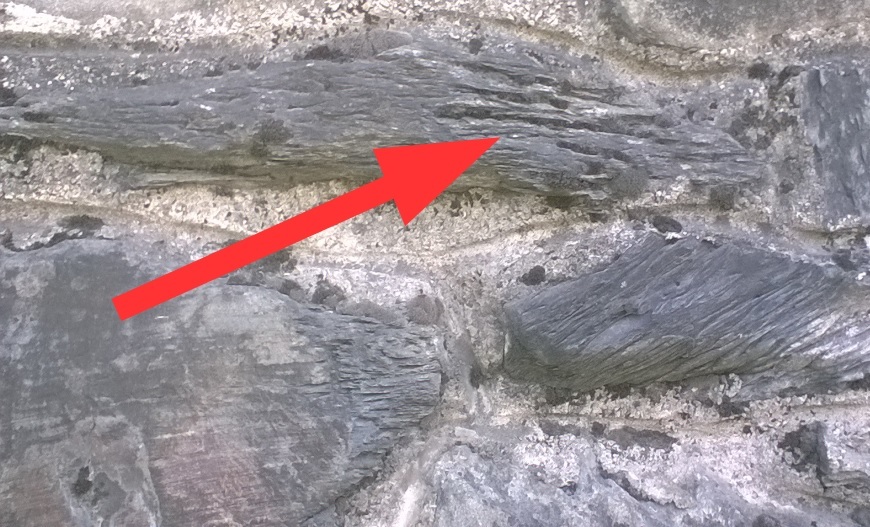
Earthcache à Bozel

Version Française :
Sur le haut du bourg du charmant village de BOZEL, vous y aurez une très jolie vue , cela venant agrémenter cette visite sur l'aspect géologique de cette Earthcache.
Au point de départ avec les coordonnées de la page, je vous propose de découvrir quelques aspects géologiques des roche présentes et visibles sur ce secteur de Bozel en Vanoise.
Le massif de la Vanoise a une géologie très complexe. La variété de ses roches (calcaires, gypses, grès, quartzites, schistes, micaschistes, gneiss…) Il est formé d'un socle cristallin (micaschistes, conglomérats de grès permiens métamorphisés, quartzite, granite, gneiss, ophiolites) surmonté selon les secteurs par une couverture sédimentaire autochtone (exemple : marbres de Pralognan)2 et de nappes de charriage formées de schistes calcaires et/ou argileux .
Le grès est une roche sédimentaire , issue de l’agrégation et la cimentation de grains de sable. Il peut s'agir d'une roche cohérente et dure.
Le granite est une roche plutonique magmatique à texture grenue, riche en quartz, qui comporte plus de feldspath alcalin que de plagioclase. Il est caractérisé par sa constitution en minéraux : quartz, feldspaths potassiques (orthoses) et plagioclases, micas (biotite ou muscovite). Le granite et ses roches associées forment l'essentiel de la croûte continentale de la planète
Le schiste est une roche qui a pour particularité d'avoir un aspect feuilleté, et de se débiter en plaques fines ou « feuillet rocheux ». On dit qu'elle présente une schistosité. Il peut s'agir d'une roche sédimentaire argileuse, ou bien d'une roche métamorphique. Nous observons ici et là du schiste ardoisier un peu partout.
Les calcaires sont des roches sédimentaires, tout comme les grès ou les gypses, facilement solubles dans l'eau , composées majoritairement de carbonate de calcium CaCO3, mais aussi de carbonate de magnésium MgCO3.
Le gypse est une espèce minérale composée de sulfate dihydraté de calcium de formule CaSO4·2H2O. Le mot gypse désigne ainsi à la fois un corps chimique composé minéral naturel et une roche évaporite majeure
Au Sud, La Dent de Villard est le point culminant d'une longue crête, en grande partie boisée, qui sépare l'étroite vallée aval de Pralognan à gauche de la large zone vallonnée de Courchevel à droite. Cette crête est remarquable par son profil et sa couleur uniformément blanche des roches qui la constituent et par son relief de détail très particulier, très raviné sur ses flancs et "lunaire" sur sa crête. Cette montagne est formée presque entièrement par des gypses triasiques.
Ici, nous allons nous contenter de quelques observations à partir du point N45°26.639 E06°38.840
"Loguez cette cache "Found it" et envoyez-moi vos propositions de réponses aux trois questions ci-dessous soit via mon profil, soit via la messagerie geocaching.com (Message Center), et je vous contacterai en cas de problème." .
-
La tour SARAZINE que vous avez en contre-bas est construite en pierre. Selon vous, quelle roche y est majoritairement présente ?, expliquez en une phrase
-
Plein sud, la pointe du Villard est composée d'une roche très blanche, quelle est cette roche composée majoritairement de sulfate de calcium.
-
Au point ou vous êtes, vous avez un bloc de roche stratifiée près du réverbère, (image1) 60 cm au dessous, juste à la verticale, se trouve une roche avec deux particularités donnez ces deux particularités.
-
Une photo sera prise lors de votre passage montrant votre visite et jointe à votre log.
Image 1: 
((Il ne sera pas utile d'attendre pour loguer en « Find-it » mais, sans message indiquant vos réponses, votre log serait supprimé).).
English version :
On the top of the village of the charming village of BOZEL, you will have a very nice view, it comes to decorate this visit on the geological aspect of this Earthcache.
At the starting point with the coordinates of the page, I propose to you to discover some geological aspects of the rocks present and visible on this sector of Bozel in Vanoise.
The Vanoise massif has a very complex geology. The variety of its rocks (limestone, gypsum, sandstone, quartzite, schist, micaschist, gneiss ...) It is formed of a crystalline basement (micaschists, conglomerates of metamorphosed permian sandstone, quartzite, granite, gneiss, ophiolites) topped by sectors by an autochthonous sedimentary cover (example: marbles of Pralognan) 2 and layers of bedload formed of limestone schists and / or clay.
Sandstone is a sedimentary rock, resulting from the aggregation and cementation of sand grains. It can be a coherent and hard rock
Granite is a quartz-rich, quartz-rich, magmatic plutonic rock with more alkaline feldspar than plagioclase. It is characterized by its constitution in minerals: quartz, potassium feldspars (orthoses) and plagioclases, micas (biotite or muscovite). Granite and its associated rocks form the bulk of the continental crust of the planet
Shale is a rock that has the particularity of having a laminated appearance, and to be sold in thin plates or "rocky sheet". It is said to have schistosity. It may be a clayey sedimentary rock, or a metamorphic rock. Here and there we observe shale slate everywhere.
Limestones are sedimentary rocks, just like sandstones or gypsums, easily soluble in water, composed mainly of calcium carbonate CaCO3, but also magnesium carbonate MgCO3.
Gypsum is a mineral species composed of calcium sulfate dihydrate of formula CaSO4 · 2H2O. The word gypsum thus designates both a chemical body composed of natural mineral and a major evaporite rock.
To the south, La Dent de Villard is the culmination of a long ridge, largely forested, which separates the narrow valley downstream of Pralognan to the left of the wide hilly area of Courchevel on the right. This ridge is remarkable for its profile and its uniformly white color of the rocks which constitute it and for its very particular relief of detail, very ravined on its flanks and "lunar" on its crest. This mountain is formed almost entirely by Triassic gypsum.
Here we will be satisfied with observations from point N45 ° 26.639 E06 ° 38.840
"Log this cache" Found it "and send me your suggestions for answers to the three questions below either via my profile or via geocaching.com (Message Center) messaging, and I will contact you if there is a problem."
-
The SARAZINE tower that you have below is built of stone. According to you, which rock is predominantly present?, Explain in one sentence
-
Full south, the tip of the Villard is composed of a very white rock, what is this rock mainly composed of calcium sulphate
-
At the point of view, where you are, you have a block of rock laminated near the lamppost, (picture1) 60 cm below, just in the vertical, is a rock with two peculiarities give these two peculiarities
-
a picture will be taken during your visit schwing your visit and joined to your log
Picture 1: 
(It will not be useful to wait to log in "Find-it" but, without a message indicating your answers, your log would be deleted).